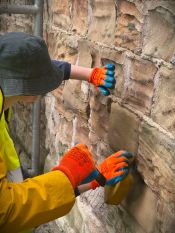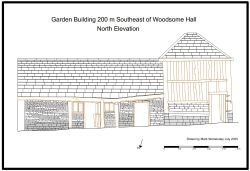Clay Infill found in Exeter's Grand Royal Clarence Hotel
Womersleys, guided by Buttress Architects, have sampled and analysed mortar samples at the fire damaged Royal Clarence Hotel in Exeter to inform mortar specification, for the rebuilding of the hotel. The aim was to provide additional information on the mortar used to construct the walls, infill early stud work and to plaster this group of buildings.
The earliest mortars samples in this complex of buildings are bound by clay and appear to date from the seventeenth century. In the later samples the clay forms the binding agent within cob infill to early timber framed panels. This build up is found in Devon in early Town Houses. Internal walls constructed of earth and timber were in common use up to the eighteenth century. There are remnants of clay plaster/daub residue on the chimney breasts of the well house and below later plasters on the North East wall of the first floor stairwell. Within Devon sieved earth and hay/animal hair based daub/plaster remained in use, even in very grand houses, right up to the 1850s.

Devon contains more earth buildings than any other county in Britain, some dating from the 15th century. Around Exeter can be found Permian, (a period of the Paleozoic Era occurring from about 280 to 230 million years ago), red sandstones and breccias, together they are known as the New Red Sandstone. These sedimentary rocks were formed when sediment was deposited and compacted to form a rock. Beccias contain angular gravels, as well as finer sediment.
Above these deposits are characteristic red Devon soils, mainly caused by weathering of the underlying red rocks, and can be seen over wide areas, even where a cover of red rocks used to lie before being removed by erosion. This soil makes excellent cob, clay plaster and daub. This is because, firstly, most contain a proportion of volumetrically stable clay, which are fairly coarse, do not expand or contract excessively and provide adequate cohesion. Secondly the soils are usually well graded with coarse gravel (over 5mm), 30-40%, through to fine and coarse sands, 25-30%, sand, silt 10-20% and clay 10-25%. Once water and straw, wheat or barley, or hay is added a good cob infill can be created and if the larger gravels are sieved out first a low shrinkage daub or plaster is formed.
Related Articles

The steps members of the Waterton’s Wall restoration team, with support from Mark Womersley, have been following to consolidate, conserve and repair this historic wall that represents the successful efforts of Charles Waterton to preserve the wildlife that lived on his estate near Wakefield in West Yorkshire.
1. Fill deep voids behind the wall’s facing stones with deep pointing work. The works involve …

Mark spent a day recording a historic timber-framed garden building at Woodsome Hall
Mark Womersley, as part of his voluntary work with the Yorkshire Vernacular Buildings Study Group, spent…

M Womersleys were delighted to offer a day of tutoring to those who attended the Wentworth Woodhouse Working Party
M Womersleys were delighted to offer a day of tutoring to those who attended the Wentworth Woodhouse…